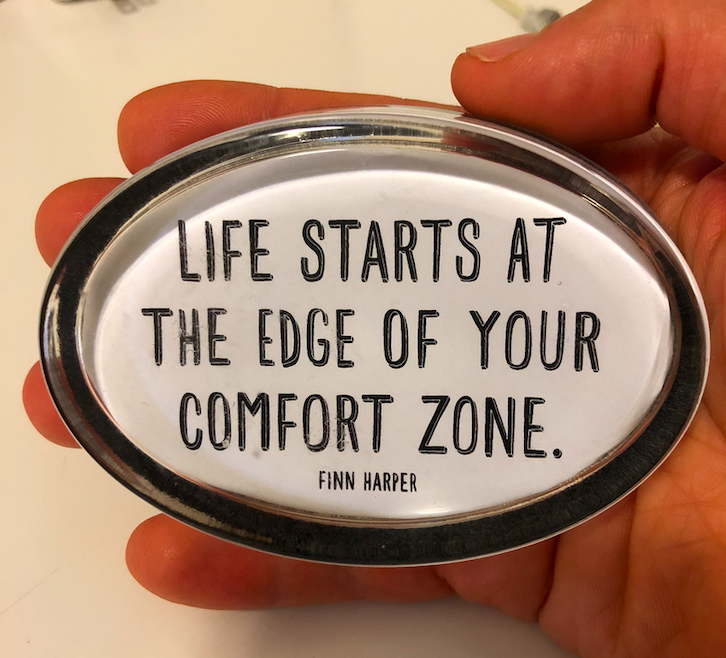We all have a gap between where we are now and where we want to be — This is the gap of continuous personal growth.
You might find this gap scary, exhilarating, or overwhelming.
Most likely, it’s all of the above.
The emotional tension of staring at your potential in the face, wide-eyed yet cautious, hopeful yet full of self-doubt, is a unique part of being human.
It should scare you because you’re capable of far more than you can imagine.
It should motivate you because it represents a bigger and brighter tomorrow if you’re willing to go there.
Yet if you don’t have the right supports, mindset, and opportunities to fulfill your potential, thinking about this gap can be downright depressing.
There are few things more painful than feeling as if you aren’t living up to your potential.
What’s worse is living in a world that is stacked against you, replete with narratives that you aren’t good enough, capable enough, or smart enough to succeed.
If you let these disempowering stories take root in your mind, you’re unlikely to change your life. You’ll always be steps from where you want and a victim to circumstances beyond your control.
You need to find the part of you that sees this gap as an opportunity to grow, not an excuse to stay put.
Continuous personal growth is about honoring and feeding that part every day. Here’s how.
Growth Starts Where Imagination Meets Discomfort


Meaningful learning and growth happen at the edge of what you’re currently comfortable with feeling and capable of imagining.
In order to feel more, you need to be willing to sacrifice some comfort — Not abandoning comfort completely, but strategically and purposefully relinquishing your addiction to the path of least resistance.
In order to imagine more, you need to be willing to let your mind contemplate the unthinkable. This does not mean letting go of reality and getting lost in delusion. Rather, finding a way to go beyond what you can see clearly and pull on the threads of what’s possible to unravel a bigger vision.
Together, these challenges of feeling and imagining more point back to two places where people stumble:
- Sacrificing the known for the unknown.
- Bringing the unknown back to the known without getting lost.
This first challenge speaks to the difficulty of letting go of what was (even if it was pretty good) and tip-toeing your way into what is possible. This raises questions like:
- Is it safe to let go?
- Do I have what it takes to go there?
- Am I willing to take this risk?
- What if everything falls apart?
Answering these questions requires a combination of healing past wounds and having a big enough vision to pull you forward. It takes supports, cheerleaders, and hope (more on that to come!) to fuel your journey.
If you’re empowered to edge out of your comfort zone, the second challenge is knowing when to pull-back into the comfort of the known. You must figure out how long to stay stretched-out to reap the benefits without getting stuck, lost, or burnt out.
It’s just as easy to completely blow past your comfort zone and fall apart as it is to procrastinate and avoid the very things that will make you grow.
Whether you’re familiar with pushing too hard or well sophisticated in avoidance, there are four words that can guide you to the space of continuous personal growth:
STRETCH BUT DON’T SNAP!


How To “STRETCH” For Continuous Personal Growth
There are 7 important characteristics that will help you confidently step out of the known and enter your stretch zone.
Collectively, these spell out the word “STRETCH” — Supports, Traction, Reasons, Effort, Tethers, Clarity, & Hope.
S – Supports
- Who is cheering you on?
- Who is offering guidance and support?
- Where can you rely upon others for help?
- What personal strengths and past successes can you lean on to guide you?
T – Traction
- What will you give your full attention to at the exclusion of other, lesser goals?
- How can you dig in and really focus on one thing that will actually move the needle?
- How will you manage distractions that pull you away?
- How can you quickly adapt, pivot, and change your focus to maintain traction as you learn what works best?
R – Reasons
- What’s your motivation for taking action?
- Why does this really matter to you? (I mean, really, really, really matter?)
- Why does this matter to other people and to the world?
- If you didn’t do this, what would the consequences be for you or others?
E – Effort
- How much effort will this require and are you willing to put in the work?
- What are you willing to sacrifice along the way?
- How will you constantly re-up your energy and drive to keep going?
- What will you need to do to maintain your grit?
T – Tethers
- Who can tell you if you’re getting off track?
- To whom are you accountable?
- How can you recognize the signs of getting close to snapping?
- How can you recognize the signs of not stretching enough?
- What will pull you back if you get close to the breaking point?
- What lifeline or anchor will keep you grounded when things get hard?
C – Clarity
- Do you know exactly what results you’re after?
- Do you know what skills you need to develop or learn?
- Do you have a clear picture of the micro-level daily action steps that you need to take?
- Do you have a clear understanding of the systems and environments that will help you succeed?
- Do you have a clear vision of the big-picture narrative that will frame and guide your work?
H – Hope
- Do you actually believe that you can achieve what you have set out to do?
- Do you have enough confidence to step into the unknown? If not, what people or strategies can make you more hopeful?
- Do you have faith that if you apply yourself, you can reach your goals? If not, what would you need to believe to make you trust yourself?
Answer these questions and you’ll be primed to stretch, which sets you up for the second challenge — figuring out how to not snap.
How Not To “SNAP” – The 4 Horsemen of Continuous Personal Growth


When it comes to continuous personal growth, there are four behavioral tendencies that will thwart your progress.
These “Four Horsemen of the Apocalypse” will prevent you from stepping into your stretch zone, or keep there too long and make you snap.
Collectively, these destructive behaviors and mindsets spell the word “SNAP” — Superiority, Neglect, Avoidance, & Perfectionism.
S – Superiority
- Do you think you’re right or know more? (If so, you’re derailing your growth.)
- Do you lack respect or admiration for those trying to help you?
- Do you verbally mock, joke, or attempt to claim the upper position?
- Are you attached to doing it “your way” and will either give up, shut-down, or fight back if you can’t have it your way.
- Are you unwilling to listen when someone tells you that you’re off track or reaching your breaking point?
N – Neglect
- Do you fail to do the things that actually matter?
- Are you careless about taking care of yourself and maintaining your health?
- Are you neglecting time for rest and recovery?
- Are you neglecting balance in certain parts of your life while pushing too hard in some areas?
A – Avoidance
- Do you procrastinate on projects or tasks that you know are important?
- Do you withhold, knowingly or unknowingly, from taking care of parts of your life that need attention?
- Do you avoid situations that might make you feel inadequate, challenged, or embarrassed, even if you know they may be good for you?
- Do you avoid people who hold you to high expectations because you’re afraid of taking responsibility for your potential?
- Do you withdraw and seek to escape from dealing with issues that keep showing up in your life?
- Do you engage in other seemingly important activities in a sophisticated avoidance tactic for uncomfortable feelings?
P – Perfectionism
- Do you strain towards unattainable goals, unwilling to slow down or stop until it’s “just right”?
- Do you procrastinate because of the fear of having to do something that will live up to your idealized standards?
- Do you micromanage or overly control parts of your life (or others) to adhere to your mental models of what’s right?
- Do you constantly pressure yourself to achieve more and more, even if doing so is undermines your own wellbeing?
- Are you overly concerned with other people’s evaluations of you and your work?
Together these “4 Horsemen” feed off of each other. Perfectionism and superiority can lead to procrastination and avoidance. If you think you know better and will only do things on your own ideal terms, you’re unlikely to listen when people are telling you there’s something you’re missing Over time, this pattern turns into neglect, and before you know it, some part of your life will be primed to snap.
When one horseman shows up, the others usually aren’t far behind. Therefore, don’t passively wait until these horsemen are negatively affecting you. Be proactive about identifying where these factors show up in your life and seek to overcome them.
Stretching Is Uncomfortable But Not Unsafe


You only know what you’re capable of by stretching yourself, and stretching yourself, and stretching yourself.
True, but to make your stretching sustainable, you need regular periods of resting in your comfort zone.
As you practice this cycle of stretching and recovering, you will begin to realize that feeling uncomfortable is not the same as being unsafe.
This distinction between comfort and safety is crucial because no meaningful growth can happen if you don’t first feel safe.
Knowing you’re safe allows you to stay present in your body and connected to your deeper motivation and energy, even when it uncomfortable. It allows you to stretch into the unknown knowing you have a robust comfort zone to support you.
Continuous Personal Growth Doesn’t Happen In A Vacuum
Despite what some self-help books might tell you, personal development does not exist in a vacuum.
Added social and cultural resistance must be accounted for. The context of your social privileges, relationships, and positionality will impact how your stretch unfolds and when snapping begins.
Continuous personal growth is much more difficult when the world is trying to push you down. If you’re part of a marginalized identity or systematically disempowered group, you’re not only fighting against your own insecurities, but also against policies and power that don’t want you to stretch.
Assess whether it’s actually unsafe for you to step out of the known and stretch. The costs of letting go of the known may be higher if you’re already disadvantaged by society.
For this reason, you must never compare your stretch to other peoples’.
Don’t get caught up wondering how others might seem to stretch further or longer. They might have inherited privileges that enhance their ability to stretch, or equally as likely, there are parts of their life that are snapping that you just can’t see.
As a culture, we glorify the stretch. We laud the and chase after the success story of growth, often at the cost of asking whether this growth is sustainable.
We also tell stories of growth as a product of individual effort while minimizing the social detriments that help or hinder someone’s progress.
Continuous personal growth is about controlling what you can in order to seed your own development, while also honoring and acknowledging the cultural constraints that shape you for better or for worse.
There will always be an inner and an outer dimension to personal growth. One without the other is incomplete.
If you take personal growth seriously, you need a framework that can guide you past your inner doubts and guide you through outer constraints. You will need to have the right people, supports, and beliefs to sustain you in the long run, as well as the right tethers, checks, and balances to keep you from snapping once you gain momentum.
Apply the “Stretch but don’t snap” principles, customize them for your personal and cultural context, and turn world around you into something more free, strong, and beautiful.
I eagerly await to see the tremendous growth you can achieve.
Finding the right stretch,
~ Jeff Siegel




1 Comment